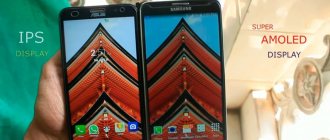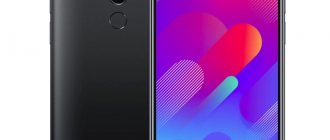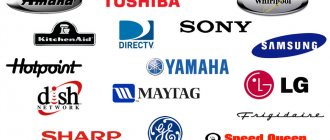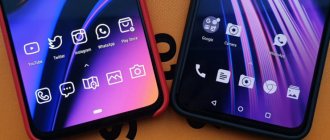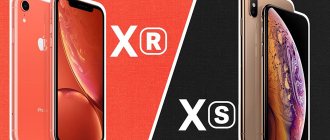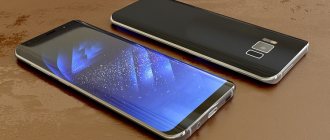When creating new TV models, manufacturers try to use the newest and most modern technologies. Not long ago, the world saw OLED TV models, which differ from IPS and other technologies in high performance and some other characteristics. This is due to the fact that such panels do not require light filters or additional lighting. Also, this feature allows such TVs to be thinner and easier to manufacture than models with IPS technology. But let's first understand what, in general, an OLED display is and how it works.
An OLED TV is a TV whose matrix is mainly composed of carbon-based organic light-emitting diodes. Such screens are often installed in players, phones and other gadgets. It’s not easy for an ordinary person to imagine such a combination, but it works like this: electrical impulses pass through organic light-emitting diodes, causing them to glow. The color that each of these diodes will glow depends on the color of the phosphor with which it is coated. As is customary, this is a red, blue or green phosphor, the combination of which allows you to obtain a huge number of other colors and shades. OLED TV has the shortest response time among all TVs, a wide viewing angle and excellent light transmission. Such screens have many advantages, but also have their disadvantages. Let's discuss all this in order.
How does it all work from the technical side?
In order to create organic light-emitting diodes, thin-film structures with a large number of layers made of polymers are used. When current is applied to the positively charged anode, the electrolytes in the device flow from the negatively charged cathode to the anode. In this case, the cathode gives electrodes to the emissive layer, and the anode takes them from the conductive layer. Thus, the conductive layer becomes positively charged and the emissive layer negatively charged.
Under the influence of voltage, negative and positive particles begin to move towards each other and at certain moments recombine. At the same time, negative particles in such technologies move much faster, and the recombination process occurs near the emission layer. During this process, the energy of the electron is reduced and electromagnetic radiation is released in the visible light region. If the anode is negatively charged, the display will not work, since the electrons will move in a different direction and recombination will not occur.
The anode is often made of indium oxide, which is doped with tin. Such an anode has a high work function, which facilitates the injection of so-called holes into the polymer layer. In addition, it is transparent to visible light. The cathode is often made of calcium or aluminum, since these metals have a low work function.
How OLED TVs are made
Oled TV is manufactured in several stages:
- Selecting a substrate;
- Preparation of the substrate before applying organic light-emitting diodes and other materials to it;
- A control board is manufactured for such radiating sources, both the control system itself and the switching circuits.
- Drawing the structure of certain elements and the organic layer.
- The workpiece is sealed to prevent dust, moisture and air from entering it.
Organic layers, as well as patterns on them, can be applied using several options. Today, all OLED TVs are made using an FMM shadow mask, which stands for Fine Metal Mask. With its help, a template can be applied to organic matter. After this, those areas of the OLED material that are not covered by the template are removed in a vacuum chamber using evaporation. This is the simplest method, but it is not effective enough, especially when producing such large panels.
There are other application methods, such as inkjet printing or laser annealing. Such methods of depositing organic materials are more efficient and thanks to them, creating OLED panels is much easier.
Materials for OLED TVs and their classification
Today, there are several materials for creating OLED panels. They are mainly divided into two types:
- Consisting of large molecules (P-OLED) - such materials are applied using inkjet printing or by centrifugation. R-OLED has enormous technological capabilities and potential.
- Low molecular weight (OLED) - this material helps make OLED displays much better thanks to evaporation technology. Today, scientists are developing other methods of applying organic material.
However, there is another classification, in which the materials used are divided into:
- Phosphorescent materials are associated with the future of lighting panels. Also, with their help it will be possible to create a large OLED display, but so far such materials do not last as long as we would like.
- Fluorescent materials will last longer, but they are not as effective as phosphorescent materials.
Samsung OLED TVs combine these two materials. Thus, OLED TV uses fluorescent light sources for green and blue colors, and phosphorescent ones for red ones.
OLED displays and their types
Monitors of this type are divided into several types, depending on control methods and other features. We can especially highlight the following types of screens:
- PMOLED monitors have controllers for scanning patterns into columns and rows. This means that the pixel that should light up is calculated by row and column. In order for the entire screen to light up, the location of each pixel must be calculated at high speed. OLED displays are mainly used in LG cameras and other small equipment.
- An AMOLED screen, compared to an IPS screen, has the ability to directly control each individual pixel, which speeds up playback. The diagonal of such screens can reach up to 40 inches, but their cost is much higher than that of IPS screens.
- TOLED is a technology that allows you to create transparent screens and achieve the highest level of contrast. In this case, the light can emit up, down or in both directions. The OLED display has only 70% transparency, and this allows it to be used on a store display, in a virtual reality helmet, etc. It can also be combined with many opaque materials that serve as a substrate. Using this technology, it is possible to create devices with a large number of layers or hybrid, for example bidirectional, matrices.
- FOLED. One of the main features of this technology is the ability to create flexible displays by applying organic light-emitting diodes to a flexible plate made of plastic or metal. OLED technology has a particularly thin, light display weight, flexibility, strength and durability.
- SOLED allows you to create folded OLED devices. With this technology, red diodes are arranged in series. At the same time, it is possible to control each element, as well as adjust the color of each pixel by changing the voltage.
Compare the incomparable
LCD vs LED
LCD, TFT, LED, AMOLED and other “ices” are just abbreviated designations, and the differences between them are an abyss. Moreover, some of these concepts are incomparable. So, no one will tell you which TV is better: LCD or LED, since LCD ( L iquid C rystal D isplay ) is a liquid crystal display or simply LCD, and LED ( Light E mitting Diode ) is one of its types backlight (LED). That is, the TV can be LCD and LED at the same time.
The block diagram of an LED-backlit LCD screen is shown in the figure below:
LED backlighting, unlike outdated fluorescent backlighting (CCFL), ensures uniform distribution of light across the screen surface and a higher level of brightness. In addition, it consumes less energy and lasts longer.
TFT vs LCD
“What about a TFT TV? Is it better than LCD or worse? Neither one nor the other, because TFT ( Thin F ilm Transistor ) is an active matrix LCD display, a type of LCD . An active matrix is a display color control system where each pixel is controlled by its own group of thin-film microtransistors.
Unlike a passive matrix, where the pixel shade is adjusted linearly (in rows and columns), an active one reacts 5-6 times faster to changing images, has higher brightness, contrast and viewing angles, and also consumes less energy.
LCD screens of all modern TVs, monitors, smartphones and tablets have an active matrix, so it is inappropriate to compare LCD and TFT with regard to these devices.
TFT vs IPS. IPS properties and versions
“But IPS screens are definitely better than TFT, it’s not for nothing that they write about this on the forums!?” And again, those who write this are wrong. IPS is a type of TFT. Same as TN, PLS, VA, MVA, PVA and others. TFT displays are sometimes mistakenly called TN ( Twisted N really do not shine with picture quality - of all TFT options, they have the worst color reproduction, the lowest brightness and contrast, and very limited viewing angles. But TN screens are characterized by low cost, fast response and high refresh rates.
This is interesting: Similar, but not the same: strengths and weaknesses of HDMI and DisplayPort interfaces
Comparison of IPS and TN displays.
IPS ( I n P lane S witching) is the next step in the development of active matrix technology, which eliminates the main disadvantages of TN. Changing the position of the crystals and the voltage points on the cell resulted in the black color becoming truly black, and when looking at the screen from the side, the colors remain the same as when looking at it from the front. In addition, IPS screens have noticeably improved color reproduction and increased overall brightness and contrast, but the response speed, on the contrary, has decreased compared to TN.
Today, IPS is being developed in parallel by 3 companies - Panasonic (took the baton from the developer of the first version - Hitachi), NEC and LG. Each version and generation of this technology has its own characteristics and names.
- The Hitachi and Panasonic line includes: IPS (Super TFT), S-IPS (Super-IPS), AS-IPS (Advanced super-IPS), IPS-Pro (IPS-provectus, IPS alpha, IPS alpha next gen).
- NEC developments are called: SFT (Super fine TFT), A-SFT (Advanced SFT), SA-SFT (Super-advanced SFT), UA-SFT (Ultra-advanced SFT).
- LG products are called: S-IPS (Super-IPS), AS-IPS (Advanced super-IPS), H-IPS (Horizontal IPS), E-IPS (Enhanced IPS), P-IPS (Professional IPS), AH-IPS (Advanced high performance IPS).
Samsung is also developing own version of IPS, called PLS ( Plane to Line Switching
LED matrix.
All developers improve technology in the same directions. This means a reduction in response time, an increase in contrast, depth and naturalness of color, an improvement in viewing angles, the elimination of color distortions, a reduction in energy consumption, and most importantly, a reduction in the cost of matrix production. Computer monitors with IPS screens of recent years are already “stepping on the heels” of TN in terms of response speed and can be used not only for professional graphics, but also for dynamic games.
Most users, except, perhaps, professionals in the field of graphics and design, will not notice the differences in images on IPS displays of different brands, but there are quite significant differences between their budget and top-end versions. The highest image quality is reproduced by P-IPS and AH-IPS matrices manufactured by LG. They are also the most expensive.
VA/MVA/PVA
VA , MVA and PVA matrices occupy an intermediate position between TN and IPS in both image quality and price. Compared to TN, they have wider viewing angles and more accurately convey the depth and naturalness of color; compared to IPS, they are cheaper. However, these types of screens are not widely used. They are used in the production of PC monitors and budget TV series.
Benefits of OLED technology
This technology, used to create an OLED display or TV, has a number of advantages:
- Energy efficiency. Such TVs from LG consume a fairly small amount of energy, which is achieved due to the fact that the monitor does not require additional backlighting. This is due to the fact that each LED not only produces a specific color, but also emits light.
- Stylish appearance. Due to the fact that there is no need to additionally install a backlight, the thickness of the screen is also reduced, which means that the weight of the equipment will also decrease. In addition, thanks to the ability to place LEDs on a flexible polymer substrate, curved, transparent or flexible OLED displays can be created.
- Brightness and contrast. Such TVs have a brightness that can reach 100,000 cd/m2. For TVs with other technology, for example, IPS, this level is simply unattainable. The contrast in such TVs is also better. With OLED you can reach 10 million to 1 and that's not the limit.
- Huge viewing angle, that is, you have the opportunity to watch TV from any angle without distorting the picture.
- Maximum response speed up to 0.002 ms. No other TV, including those with IPS technology, can match this speed. Thanks to this speed, the picture is more realistic.
What to choose?
In fact, AMOLED and OLED are two extremely similar technologies. AMOLED has firmly established itself in the smartphone market and this is where we will find most devices with this technology. Energy efficiency is extremely important for phones because it allows for longer battery life per charge cycle.
OLED displays are virtually unrivaled in the TV market. The biggest brands assemble panels for the top models, offering users perfect images, deep blacks and perfectly reproduced colors. This is the technology you should choose when purchasing as it provides the best value for money and also generates excellent colors.
Unfortunately, it's impossible to pick a unanimous winner in the OLED vs AMOLED comparison. Of course, both solutions are much better and more promising than IPS screens. However, such devices are a good compromise for budget-conscious people. If image quality is not that important to you, then an IPS panel should meet your expectations.
| IPS | OLED | AMOLED | |||
| pros | Minuses | pros | Minuses | pros | Minuses |
| Color rendition | Low contrast level | Perfect black | High price of devices | Wide viewing angles | Oversaturated images |
| Low price | High Contrast | Risk of image burn-in (afterglow) | Large color gamut support | ||
| Durability | Realistic colors | Excellent black performance | |||
| Highly smooth movements | Long battery life when using darker colors | ||||
OLED display and its disadvantages
Despite the positive aspects, such TVs also have their drawbacks, although there are not many of them.
- Short service life of diodes of some colors. For TV, diodes corresponding to RGB colors are used, which are fundamental. The problem with OLED panels is that the blue diodes die before the others. On average, organic LEDs of a given color last no more than 3 years.
- The high price of such screens. This is due to a large number of defects, as well as rather expensive procedures related to quality control. Because of all this, it is difficult to produce monitors with large or medium-sized displays. However, even among small-sized displays there are many defects. Until now, some companies have OLED displays with a large number of shades of green.
Main directions
Independent research on the creation of OLED matrices among scientists from different countries contributed to the emergence of LED displays that differ in type and purpose. Each technology has its own practical advantages and, therefore, development prospects.
TOLED (Transparent OLED) – positioned as a transparent organic light-emitting device. Technologically, it is possible to set any direction of radiation, including two-way. TOLEDs are distinguished by a high-contrast image and transparency of the film when turned off, which significantly expands the scope of their application.
FOLED (Flexible OLED) – is implemented by fixing an organic film between flexible electrodes. The electrodes can be either the thinnest aluminum foil or a transparent film borrowed from TOLED. Thus, it is possible to create flexible transparent screens with a wide range of capabilities, placing them on the windshield of cars and airplanes. There are already TVs with curved OLED displays on sale.
SOLED (Stacked OLED) is a structure of vertically stacked organic light-emitting diodes. Each subpixel (blue, red, green) is located on top of each other, which allows you to increase the screen resolution several times. An undeniable feature of SOLED is its color fill factor of 100%. This means that when the screen color is set to red, all pixels will glow only red. Enabling a similar mode in displays with a horizontal structure will turn off the blue and green pixels. As a result, so-called gaps will appear, which will become noticeable on large diagonal screens.
It is obvious that the subsequent development of OLED technologies consists of the combined implementation of these techniques and the production of flexible transparent high-contrast displays.
A separate line is worth highlighting OLED white light panels. Their practical implementation is simpler, since it eliminates the need to create separate pixels and control matrices. Using a phosphor you can set any shade, and by changing the current you can adjust the brightness. Large panels can be used as economical ceiling and wall lamps.
OLED TVs and LED. What's the difference between them?
| Qualities | LED | OLED |
| Color space | They have a high color rendering index, like ips. | They convey a greater number of shades that are visible to the human eye. |
| Black level | The black depth is better than other technologies, but the backlight makes it difficult to achieve maximum depth. | The maximum depth of black color is achieved as a result of the fact that absolutely no electricity flows to certain diodes. |
| Brightness | Thanks to the additional backlight, this monitor is brighter. | Due to the constant turning on and off of the diodes, the brightness of the image decreases. |
| Viewing angle | The horizontal viewing angle is 180 degrees, but the vertical one is often not so large, which leads to distortion. | The viewing angle on all sides is 180 degrees, so the picture is not distorted in flat-panel TVs. With curved models the situation is a little worse. |
| Fast response | They have a high response speed, like ips. | They transmit images with a response speed of up to 0.002 ms, which makes movements as clear as possible. |
| Screen sizes | Ice TVs have a wide range of equipment with a large diagonal. | Models with a large diagonal are practically not produced due to the high percentage of defects. |
| Dimensions and power | They have small dimensions, but are significantly inferior to OLED TVs. | Due to the lack of additional lighting, this technique is the thinnest, lightest and most energy efficient. |
| Durability | The diodes in such TVs are the most durable. | Due to problems with the blue diode, which lasts 2-3 years, LG and other companies are trying to find a way out of the situation in various ways. What this will give in the end is still unknown. |
| Price | This TV will cost you half as much as an OLED TV. | A TV with the same diagonal as ice or ips from LG will cost much more due to production features. |
Let there be light
LED
LED backlighting technology for LCD screens is available in several types. They differ in color, the location of the LEDs on the LCD panel and the method of regulating the glow.
- The type of backlight consisting of only white LEDs is called WLED . It is relatively simple in its structure, but has a limited color gamut.
- RGB LED backlight , built on red, green and blue LEDs, covers a larger range of colors than WLED, but is prone to degradation (diodes of different colors burn out at different rates), is heavy and burdensome in price.
- GB-R LED is the next step in the development of LCD, where instead of a white LED, a combined green + blue is used, coated with a red phosphor (self-luminous pigment). This solution made it possible to cover 99% of the RGB palette and get rid of the shortcomings of RGB LED. GB-R LED technology is used in AH-IPS and PLS matrices.
- RB-G LED is a variation of the previous type of backlight. Instead of blue-green LEDs, there are red-blue LEDs coated with a green phosphor.
This is interesting: CPU Fan, Cha Fan, Sys Fan, Pwr Fan: what is it on the motherboard. How to properly organize system unit cooling
Based on WLED, another standard for LCD displays has been developed - QDEF , where blue diodes are used instead of white diodes, and red and green colors are formed by a coating of quantum dots (crystals that glow under the influence of electricity) applied to a sheet of plastic. QDEF displays reproduce up to 60% of the colors visible to the human eye, which is several times higher than what WLED can achieve. And in terms of energy consumption and price, WLED and QDEF screens are approximately equivalent.
QDEF is also a version of QLED ( Q uantum-dot L ight E mitting Diode ) technology, which is based on quantum dot LEDs.
Based on the location of the light-emitting elements on the LCD panel, the following types of LED backlight are distinguished:
- Edge LED – LEDs are located linearly around the perimeter of the screen. This is economical, but does not allow achieving uniform illumination and an acceptable level of contrast.
- Direct LED – an array of LEDs is distributed over the entire display area. This technology produces a more realistic picture, but this type of panel consumes a lot of energy and is quite thick, making it difficult to install on ultra-thin TVs.
- Side lighting - diodes are located only at the edges of the screen, and lighting is provided by light guides connected to them. This type of backlight is considered optimal, as it provides uniformity comparable to Direct LED, and at the same time does not have its disadvantages.
Each of the three types of backlight is divided into 2 more - with support for local dimming (Local Dimming) and dynamic contrast (DCR) or without support. Screen images with Local Dimming and DCR look more realistic.
OLED and AMOLED
The concept of OLED, although similar to LED, has practically nothing in common with it. OLED ( Organic Light Emitting Diode ) is a display manufacturing technology based on the properties of organic semiconductors - elements capable of emitting light when exposed to current . Each subpixel of an OLED screen is a separate organic light-emitting diode. Unlike LCDs, OLED panels do not need backlighting, since they glow at each point.
Other properties and features of OLED displays compared to LED:
- Low thickness and weight due to reduced number of layers.
- Unlimited viewing angles.
- Uniform lighting.
- Minimum response time.
- Flexibility.
- Significantly greater brightness, contrast and color saturation.
- Low sensitivity to external temperatures, but high to moisture.
- Short service life and tendency to degradation: blue diodes burn out 3 times faster than red ones and almost 10 times faster than green ones.
- The dependence of resource exhaustion on the screen brightness - the higher it is, the faster fading occurs.
- Sensitivity to mechanical damage. A minor defect leads to complete failure of the screen.
- Flicker by using PWM (Pulse Width Modulation) to control brightness. OLED screens use PWM optionally.
- High price.
This is interesting: TP-LINK Archer C20 (AC 750): high-speed budget router with support for WI-FI 802.11AC
AMOLED ( Active Matrix Organic Light Emitting Diode ) is an active matrix based on organic light-emitting diodes, a combination of TFT and OLED technologies, where the latter is used as a backlight . Accordingly, AMOLED screens have the properties of both.
AMOLED technology has found wide application in the production of touch displays for mobile devices. And not only it, but also its branches of development - Super AMOLED and Super AMOLED plus.
The simple difference between AMOLED and Super is that the latter does not have an air gap between the surfaces of the touchscreen and the matrix, which increases the clarity of the picture. And the advantage of Super AMOLED is the number and location of subpixels (color components of a pixel). In the latter there are 50% more of them and they are placed more densely.
AMOLED vs IPS
The question naturally arises: which display is better - AMOLED or IPS? You already know what one and the other are, so let’s compare their characteristics in the table for clarity.
| IPS | AMOLED | |
| General characteristics of the image | Quality from medium to high depending on the type and generation of the matrix. | The quality is usually high. |
| Advantages of the image | Natural color rendering. | High brightness and contrast, deep blacks, uniform illumination. |
| Disadvantages of the image | Relatively shallow black depth, especially when viewed from an angle, non-maximum contrast, uneven backlighting. | Unnaturally oversaturated colors. Purple tint when brightness is reduced or flickering due to PWM. |
| Screen response time | From 4 to 10 ms and above. | Instant response. |
| Power consumption | Does not depend on the predominance of light or dark tones on the screen. | Depends on the brightness of the light. The higher it is, the greater the energy consumption. When white is dominant, it consumes more power than IPS. |
| Life time | 5-10 years or more. | After 15,000 hours of use, signs of degradation may appear. To increase the resource of blue LEDs, it is recommended to reduce the brightness. |
| Reliability | High. | Medium and low. Doesn't like rough handling. |
| Other Features | Inflexible, relatively thick matrix. | Thin, flexible matrix. Can be used to make curved screens and ultra-thin mobile devices. |
| Price | From low ($10) to high. | Medium to very high. |
Obviously, both technologies have both advantages and disadvantages. It is difficult to call one of them a clear leader, especially since both have prospects for development and improvement. How they will show themselves in the future, we will wait and see. In the meantime, choose what your heart is most drawn to - you will win in any case.
The present and future of OLED TVs
Today, OLED displays are used mainly in various mobile devices. However, this technology is also popular in TV. LG uses it especially actively. Moreover, many of these TVs are already made using modern technologies, that is, organic LEDs are created on the basis of quantum dots, which are better and much cheaper to produce.
Not long ago, LG released a TV with a 77-inch diagonal Ultra HD curved screen and 3D Smart TV function. Moreover, such a TV can receive and play video and other multimedia files from any type of media. In addition, new TVs from LG have an excellent acoustic system and all the above-described advantages of OLED technology. However, it is worth saying that the price of new OLED TVs from LG is quite high, which is the main drawback.
This company also released another OLED TV with a curved screen, which has the same characteristics. It is distinguished by an updated operating system and new WRGB technology, which is distinguished by the presence of an additional white subpixel, which cannot be found on TVs with IPS technology. This technology promises to provide the most realistic, clear and smooth images. In addition, the LG TV has a large number of different settings and interfaces. This model is only 4.3 mm.
In the future, LG promises to produce OLED displays of even larger sizes, as well as to develop color rendering technology and try to increase the service life of organic light-emitting diodes. Also quite promising areas of development are transparent OLED displays that can be built into car glass and windows, rollable screens, as well as lighting devices based on OLED technology. By the way, it is worth noting that some of this has already begun to be gradually applied.
Devices with OLED screen
This technology is not new. The first screens based on it were made many years ago. But for a long time, such panels had a limited range of colors, and even more often the displays were completely monochrome. Color matrices began to be used relatively recently - mainly televisions are equipped with such panels. Most often these are very expensive models, the price tag of which varies from 150 thousand to 1.5 million rubles.
Another category of products where OLED screens are regularly found is wearable gadgets. In particular, now you can buy smart watches and fitness bracelets for very little money. Such devices require such a display to reduce thickness and reduce power consumption. A standard IPS screen cannot be used in these gadgets, otherwise the battery charge will melt before your eyes. The most popular fitness bracelet with an OLED display is the Xiaomi Mi Band 2. Of course, the screen here is monochrome. But this does not prevent the device from showing all the most necessary information.
Well, smartphones with an OLED display actually don’t exist. Almost all manufacturers, without exception, have relied on AMOLED, a proprietary technology from Samsung. And this despite the fact that in the early 2000s there were push-button phones with an OLED display. Apparently, many companies have not been able to produce such screens in a compact form factor on an industrial scale. And there was not much point in this, because IPS displays were much cheaper, which had a positive effect on the price tag of the final device.

